After successfully negotiating through their first two group stage matches in this year’s FIFA Women’s World Cup, France have qualified for the round of 16. Thrashing South Korea on the opening day and navigating through an arduous Norway side on matchday two has France in pole position to end the group stage in first place.
Their final hurdle is a game against Nigeria in Rennes. Their performance against Norway was impressive and informative, to say the least. This tactical preview analysis will give you the different tactical concepts employed by both teams that could be key to victory. Playing against a team that would look to sit back and counter-attack allowed France to search for alternate solutions to victory.
Corinne Diacre talked about striking fear into the opposition after their opening game and based on their performances over their two games, they have. Even after a tight affair against Norway, teams will realise that the French can pull out a victory even under the toughest of conditions. A rigid 4-4-2 setup by Martin Sjögren made it difficult for France to find a way through in the opening 45 minutes, however, Diacre’s tactical nous and the players’ ability to persist propelled them to three points.
The Nigerians lost their opening match against Norway in relatively poor fashion but returned to form against South Korea. The Super Falcons are now fighting Norway for automatic qualification into the next round. A win over France would all but secure their position, if South Korea were to stop Norway.
“Our tactical plan is to go for it, don’t just defend because if you defend, defend there’s a big chance they can score us in the end.”- Thomas Dennerby
Squad & Lineups
Diacre sprung a surprise when she opted to drop Delphine Cascarino and draft in Valerie Gauvin against Norway. Kadidiatou Diani was moved to right-wing to provide a second striking option. Gauvin’s presence diverted the Norwegians focus off the two wingers and gave them a target in the area. They will be expected to continue in their 4-2-3-1 formation that has been a success throughout the FIFA Women’s World Cup. Their main focus will on the wide areas with Amel Majri, Eugénie Le Sommer, Marion Torrent and Diani providing the attacking impetus. Amandine Henry and Élise Bussaglia will stabilise the central areas and will look to stifle the Nigerian midfield.
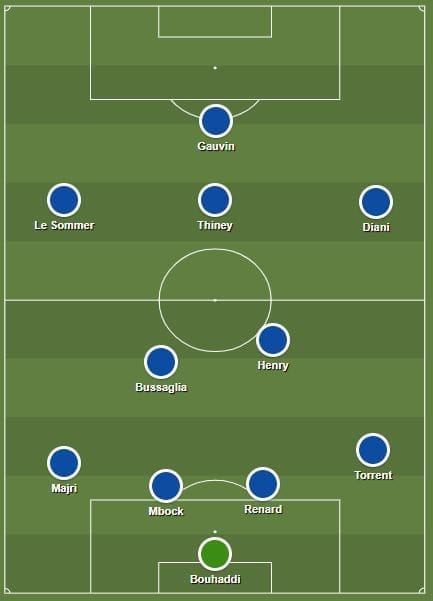
Nigeria, on the other hand, have played a number of different formations in the build-up to the FIFA Women’s World Cup. Thomas Dennerby often sets up his side in a 4-2-3-1 formation; however, whilst they opted for a 4-2-3-1 against Canada, in their previous six games, they’ve used five different starting formations. They usually employ a very asymmetrical version of the 4-2-3-1 with a reliance on the left side to attack. Once in the final third, they depend upon crosses to the striker to create chances. The also look to win the second balls near the opponent’s box so that they can maximise their chances of scoring from dangerous positions.
The assumption is Dennerby will remain cautious yet allow his side some degree of attacking freedom in a 4-3-3 system similar to the one used against South Korea. Asisat Oshoala remains a vital component for the Nigerian attack with the team focused around the Barcelona Femení forward. They prefer attacking down their left flank as the full-back and winger They will look to reinforce the central midfield area with three to aid in protecting the wide areas where France are most dangerous.
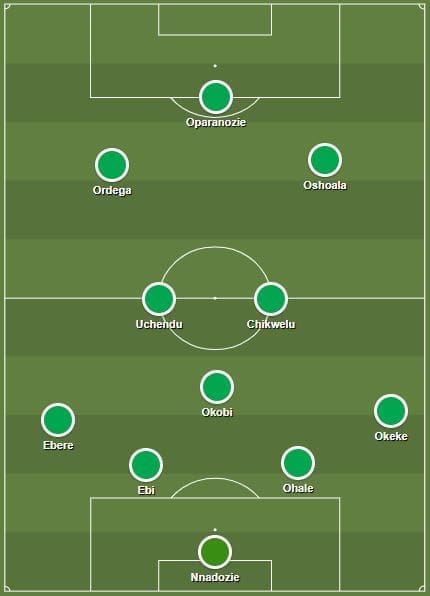
Nigeria – Heavy press
The Super Falcons play a very direct and physical game and will continue to do so against the French. One stand out feature of their play is their pressing movement. The Nigerian setup is more suited to a counter-attacking style; however, they are always looking to press players high up the pitch even after surrendering possession giving the opposition no time to rest. With their narrow attacking setup, Nigeria are easily able to involve two or more players in the press including the near sided full-back.
Instead of settling back into their own defensive shape, Nigeria look to continue their intense pressure by swarming multiple players near the ball carrier. The press is often initiated by the striker, who looks to force the opposition ballplayer to the nearest flank, which triggers the inverted winger to start her press. This top-heavy press can apply immense pressure on the opposition defenders and cause them to miss place passes the Nigerian attackers can pounce on.
If the opposition bypasses Nigeria’s forward press, they extend into midfield. The central midfielders look to converge on the opposition ball carrier by applying pressure in packs. This overload and intense pressure keeps the opposition guessing. This requires them to play an even quicker passing game or resort to long balls. The Nigerian defenders can easily deal with aerial deliveries and can regroup from there.
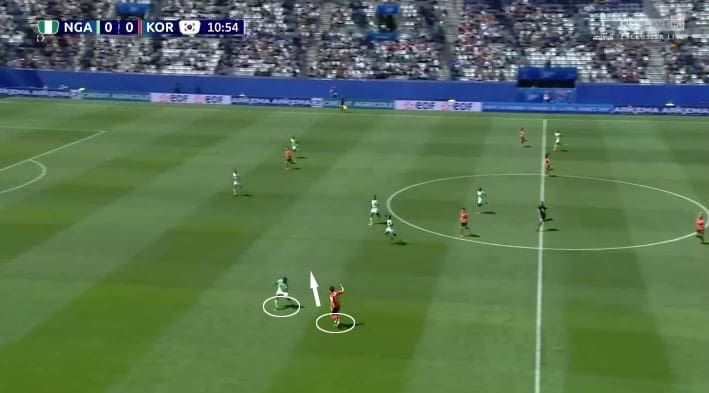
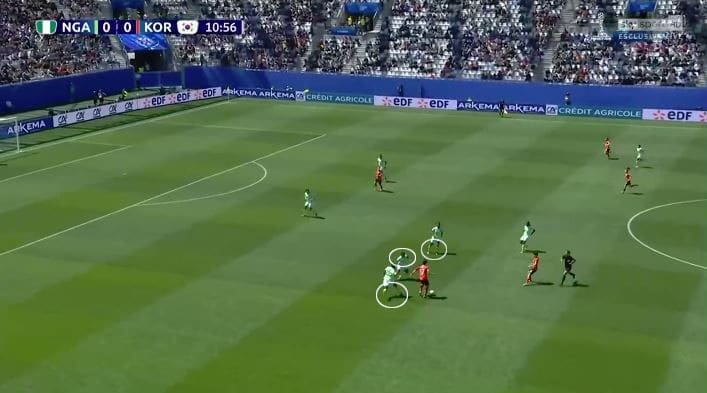
As the graphics above show, South Korea are in possession and are looking to drive into the Nigerian defence. The Nigerian full-back’s body positioning forces the Korean midfielder to drive centrally, allowing the two central midfielders to form part of the overload. This has now forced the Korea Republic to play it back towards their own goal and find another way through. Nigeria are now able to reorganise their defensive shape.
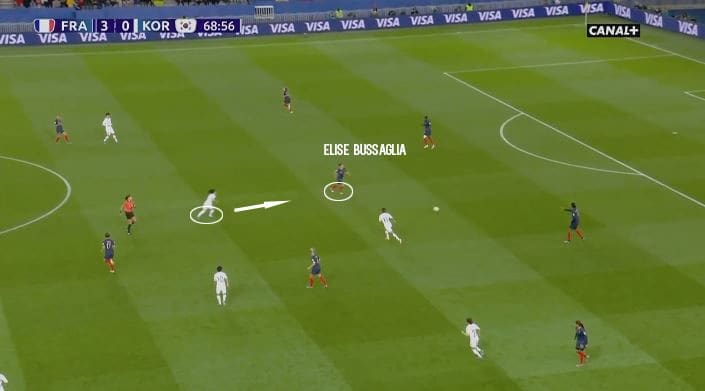
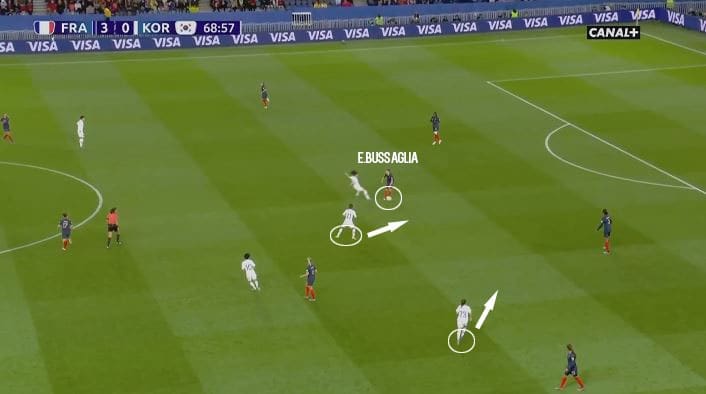
France have been susceptible to a high pressing style in the past. Against South Korea, notice how the Korean attacking midfielder rushes Bussaglia before she receives the ball. The French defensive midfielder is quickly closed down and surrenders possession because of the pressure put on her. The two Korean attackers were ready to initiate an immediate counter-attack.
However, there are flaws to Nigeria’s intense pressing style, which could give France an edge in the tie.
France’s wide players key again
France have always been reliant on their wide players as their main source of attacks. Le Sommer, Cascarino, Diani, Majri and Torrent have all played important roles and been the driving force behind France’s attacking output at this summer FIFA Women’s World Cup.
Le Sommer and Majri have been particularly vital to France’s attacking hopes having been involved in the majority of their goals. Against a vigilant Norway side both full-backs had a hand in setting up both goals. Majri’s purposeful running and cross provided the assist to Gauvin’s opener with Torrent’s run into the box brought about the foul for Le Sommer’s penalty.
Once again France’s wide players will be needed to break down a physical Nigerian defence. With Nigeria employing a heavy, intensive pressing style, the wide areas is an area for the French to exploit. Nigeria’s attacking trio are often stationed much more centrally to aid in the press and tend to favour the flank the ball is located. As a result, this leaves the opposite side exposed for the opposition to counter-attack. The combination of Diani/Torrent and Le Sommer/Majri will be ready for the switch in play and use their immeasurable pace to attack Nigeria.

As the graphics here highlight, the left-back, striker and left-winger have all pushed up to apply a high attacking press on the Canadian defender. However, this has left them exposed on the far side allowing Canada to take advantage of the empty space along the opposite flank. The edge of the frame also shows the two midfielders looking to provide support giving the opposition even more space to attack.
While Nigeria can be exposed to switches of play another apparent weakness is the high positioning of the full-backs. Taking the above example, notice the Nigerian left-back leaving space in behind for the Canadian full-back to attack. Nigeria prefer attacking down their left and primarily focus their attacks there due to their asymmetrical 4-2-3-1 formation. While this can be advantageous by applying high pressure on the opposition, it can also be exploited by higher quality teams. France’s two full-backs have excelled in the tournament with Majri and Torrent taking full advantage of any extra space being afforded to them.
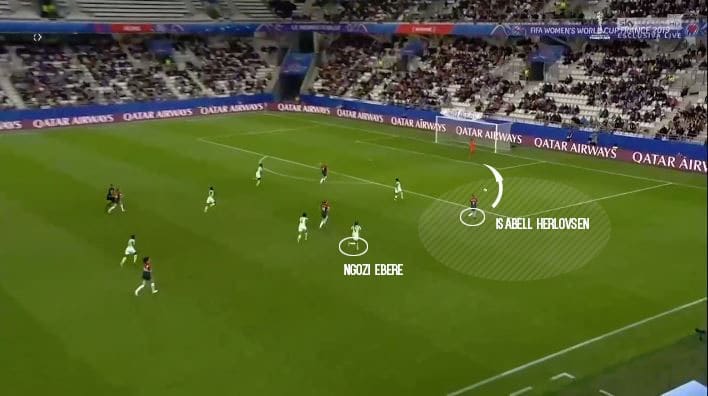
As the graphics above show, Nigeria were exposed time and time again by the Norwegian forwards. This attack originated from a central ball into the Norwegian striker Isabell Herlovsen that was then crossed into the area for Lisa-Marie Utland. The Nigerian left-back is nowhere to be seen and afforded Herlovsen an inexcusable amount of space and time. If the French wide players are afforded this much room, it could turn into a very long night for Nigeria.
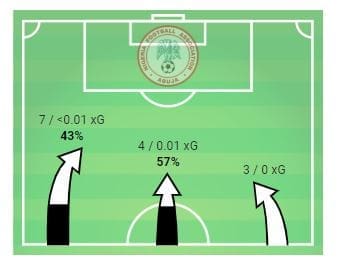
This graph emphasises Nigeria’s preference to attack down the left flank with seven shots coming from that side. Even here France have an answer in Torrent and Diani. The Montpellier full-back has proven to be a dependable figure in Diacre’s defensive line providing the balance to Majri’s marauding runs. While Le Sommer and Majri take the plaudits for their attacking exploits, Diani and Torrent have been praised for their equally exceptional defensive work. The duo work in tandem to prevent opposing teams from overrunning the right flank, putting in a defensive shift when required.
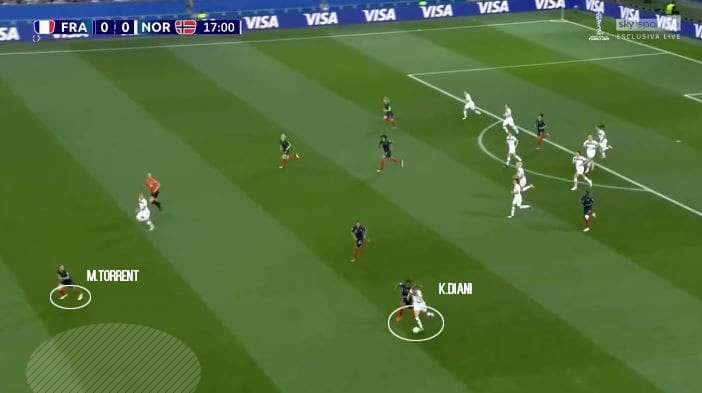
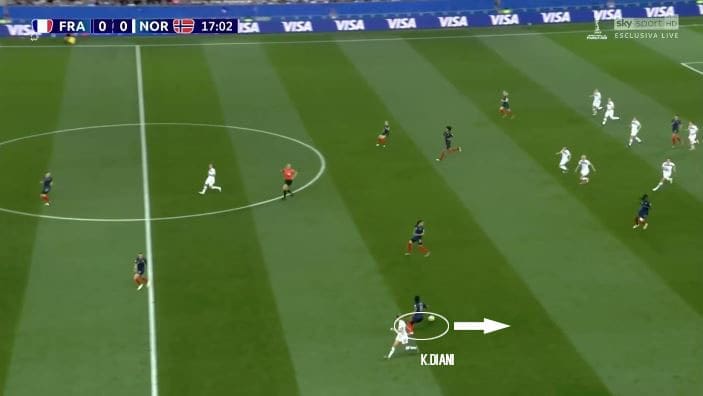
As the image above portrays, Norway had initiated a counter-attack off the back of France’s set-piece and looked to be in a two v two situation. However, Diani’s persistent running along with Torrent covering the space in behind providing her right-winger support. Diani’s efforts result in France initiating a quick counter-attack and apply pressure on Norway once again.
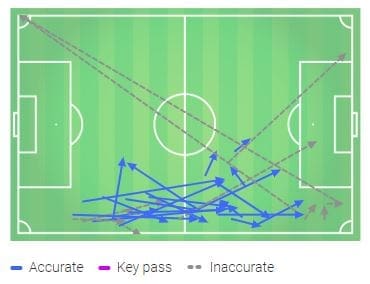
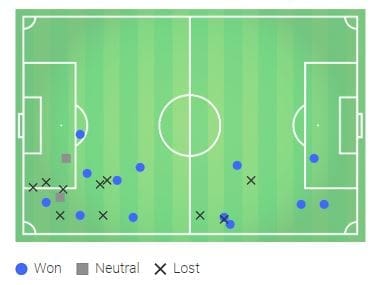
The above defensive duels indicate her ‘defence first’ mindset, winning most of her duels in the defensive third.
Asisat Oshoala key for Nigeria
Nigeria do have a dangerous asset in Asisat Oshoala. The Barcelona Femení striker has been a key component of the Nigerian side and will need to fire on all cylinders if they are to get anything from the game. Oshoala is an out-and-out striker who relies on her speed, anticipation, and work rate to score goals.
However, for Nigeria, she adopts a slightly different role and plays as a deep-lying forward on the right side of the front three. With Nigeria often employing a narrow forward line, Oshoala is able to drift into the central areas, drop into midfield and interchange positions with striker and captain Desire Oparanozie. Her trademark runs through the channels displays her intelligence that has led to her growing 11 goals for her country.
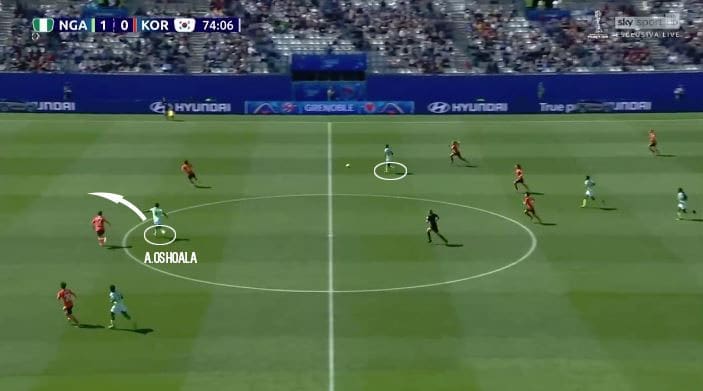
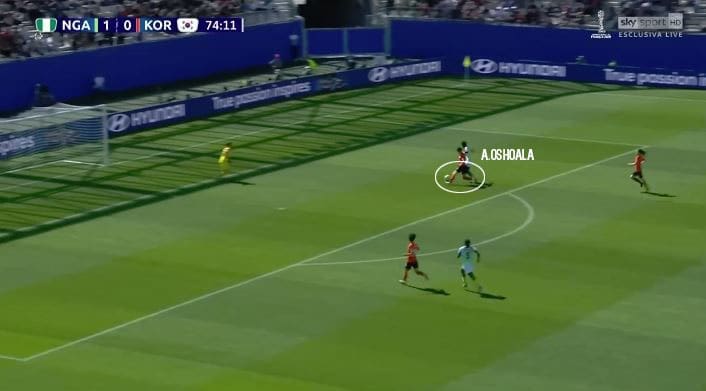
Oshoala has pace in abundance and is most potent against physically strong centre-backs where her speed is more prominent. As the graphics above show, Oshoala has switched positions with Oparanozie and is now operating as a central striker. She is sitting on the shoulder of the last defender using her intelligence by asking for the ball to be played in the area in front of her. The pass is played perfectly and it puts the Barcelona forward into an excellent goalscoring position. The second frame even highlights her physicality as she is able to shrug off the centre-back and score.
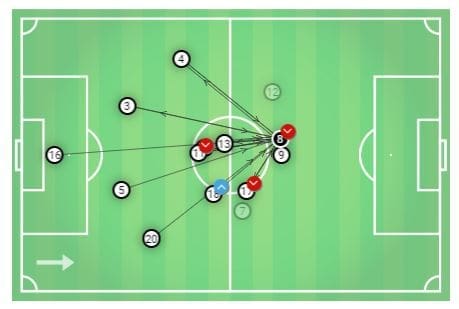
The above pass map indicates the team’s narrow structure but their willingness to play through Oshoala (#8).
Complacency test
Through the analysis, this game looks like a foregone conclusion for the French and having faced two of the tougher sides in the group, you’d be hard pressed to look past France. However, Nigeria can pose a threat with their physicality and press intensive style of play.
Once again the French full-backs will key to victory with Torrent’s defensive ability playing a more prominent role due to Nigeria’s preference to attack off the left side. Her partnership with Diani will need to stop Nigeria’s marauding left-back. Stop her and Nigeria suddenly look devoid of ideas.
France will need to be wary of their surroundings and not allow complacency to set in a few days before the round of 16 is set to begin. Corinne Diacre will ensure her troops are rallied and complete the task at hand.
If you are following the FIFA Women’s World Cup 2019 then you will find our FREE tactical preview magazine the perfect compliment to the tournament. You can download it HERE – each nation is previewed and we also profile their key player and young player to watch. Enjoy!

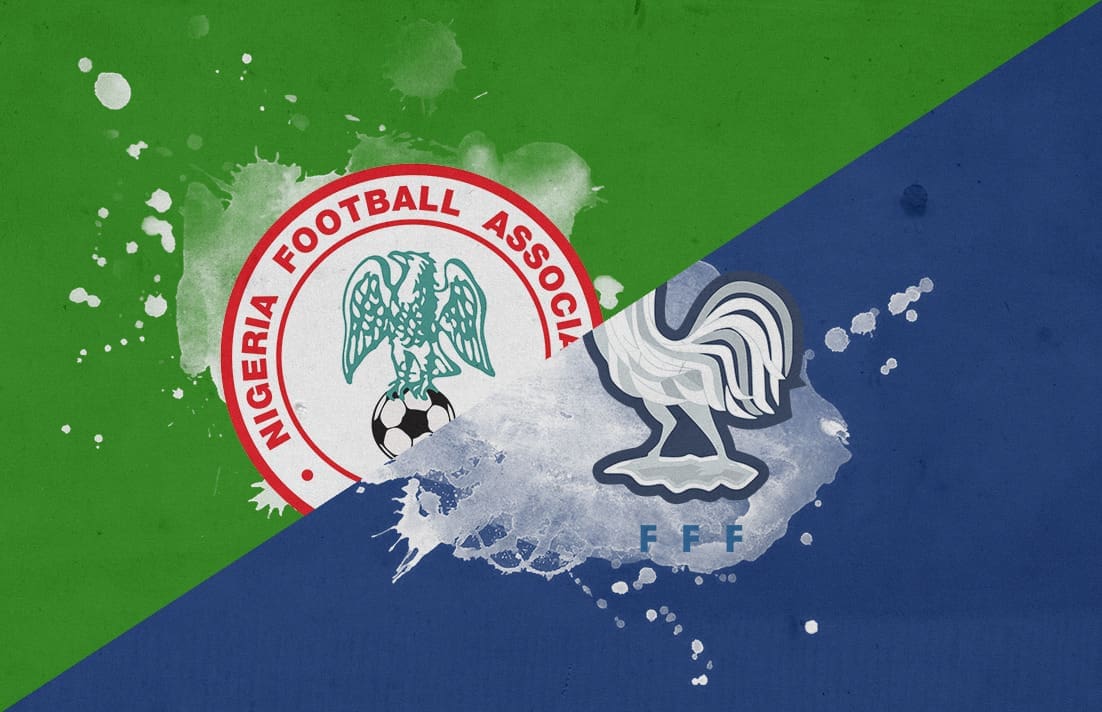




Comments